Until recently, I’ve never sought out a belly dancing performance; they’ve always just kind of happened. At Middle Eastern restaurants, it’s been a pleasant surprise when a dancer entertains the patrons – or at street fair, it’s fun to watch the women’s bodies swivel and sway as the scarves decorated in coins jingle with their every move. And though I do not pretend to be an expert on the subject, what I do understand is that belly dance in the US has been a subject of controversy – in fact, the term “belly dance” was coined in the 1890s at the World’s Fair by an American, and Western appropriation of the dance has often been associated with imperialism, burlesque, and complex misunderstandings and misrepresentations of the “other.”
Indeed, according to scholars Anthony Shay and Barbara Sellers-Young, in the Middle East, belly dance has maintained a “legitimate place in the culture, but not a serious place”; in the Middle East belly dance is not considered art. I suppose I had always shared that attitude.
Critics may argue that American-style belly dance (characterized by the use of props) strays too far from tradition and enters the realm of cabaret; however, the first time I saw Adelaide dance in American-style to the hypnotic sounds of Drumspyder at Rise: Big Sur, I felt like I was witnessing a re-working of belly dance into something culturally new and distinct, and that it was worthy of praise.
I was so impressed with her performance that I had to express my gratitude: “Thank you. That was quite amazing.”
She touched my arm, looked at me sincerely and said, “It was my pleasure.”
We continued to talk and she told me about her younger years in El Paso with her artistic mother and father, and her entrepreneurial collaborations with her sister.
“Do you have any influences aside from your family?” I asked.
When she answered, her beaming smile and enormous eyes became more serious: “I am also influenced by my Qi Gong and energy work modalities. When I perform I am always shifting energy and spreading it! I often set an intention before my shows. I allow myself to be a vessel by which energy can run through me and I can then elevate the mood of the event. People in the audience can witness the essence of the light I am playing with, and hopefully this will move them!”
Her oracular response underscored my feelings of being on the periphery at Rise.
Still, I kept in contact with Adelaide after the festival, and a little over a month later she came to San Luis Obispo to perform with Timo Beckwith and his band. Upon also seeing her at Rise, Timo was enthralled by what he called the “magic and mystery” of her dance and secured the Steynberg Gallery.
As I entered the gallery that night, I found Adelaide wearing feathers in her hair and dark armbands around her biceps, standing next to paintings for sale; until that moment, I didn’t know she was also a painter. We exchanged greetings and I asked, “Is this your first time in San Luis Obispo?”
She turned to me and told me this was her second time; her first visit, she was on tour with her band. I nodded, contemplating my new knowledge of her painting and musicianship, and wondered, “Is there an art form that she isn’t working in?” When a man came up to peruse her work, I excused myself, bought a glass of red wine, and took a seat in the front row; soon enough, the lights dimmed.
Timo and his band walked on stage. The band, all white, did not appear authentic, but when they began to play and I closed my eyes, the music swirled around me and I could imagine that I was in the Middle East.
I opened my eyes; the anticipation was tangible as the audience waited for Adelaide, but she remained sequestered behind a partition. The music continued and soon the musky smell of incense streamed into the gallery. I breathed deeply, allowing myself to feel the spirit of the music. The band finished their first song with Timo singing in Arabic, and the crowd erupted in applause; in fact, someone in the largely white, middle-aged audience cried, “Ay yai yai!”
Gradually, the music softened and slowed, and Adelaide emerged holding a few sticks of incense. She was wearing a long veil wrapped around her head and face as though it was a burka – only it was see-through, showing her bra-top underneath. She walked, catlike, down one aisle into the back of the room, silent except for the slight jingle of her hip scarf. Walking up to the front of the room through the center aisle, she placed the incense sticks at the side of the stage in a potted plant with the upmost reverence. She stepped onstage.
Slow, graceful, snakelike, and fluid, Adelaide moved her body in small waves and soft, staccato hits. She gently clasped the long, sweeping fabric draped across her body, and obfuscating her movements, she created something of an optical illusion, as though the veil had attached itself to her hand. In an effortless motion she removed it from her face, head, and body.
The music quickened. Her movements became larger, faster, and more layered as she twisted, lifted, rolled, and rotated. While her elbows and knees shifted between slight and sharp bends, and her feet and hands added the finishing touches to her every movement, she balanced the integration of her whole body (even her eyebrows!) with perfect isolation.
In her muted, nouveau-tribal, forest green and maroon outfit, she detached another veil from her body with a near-invisible movement and began to spin. The two veils spun with her in what seemed to defy the laws of gravity and matter – she joined the two in an endless loop around her like wide fairy or butterfly wings. She encased herself in the fabric, smiling at the center. When Adelaide stopped spinning, she held the wings at her back and began to shimmy, which was so precise and controlled that it was far more like her body was trembling.
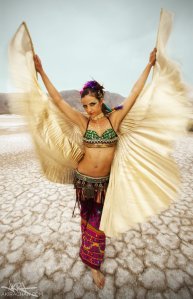
courtesy of Art by Adelaide
Thought these aren’t the same style veil she used in the above description, it shows the effect.
In a moment, the song was finished. As the crowd cheered, she walked off stage and brought back a sword – a scimitar shaped like a crescent moon. She traced the sword along the length of her body, finally resting it on her hip. Moving into a backbend with the sword balanced on her hip, Adelaide appeared to be more of a contortionist and magician than a belly dancer.
Rising, her whole body shook while she lifted the sword and placed it (narrow side down) on her head. Standing on one foot, she lowered herself to the floor; propped on one leg, her body quivered purposefully and her belly moved like ripples on water. She turned to face the audience and, lying on her torso, she put her leg above her head – all without ever adjusting the sword. After transitioning between a few yoga poses, she rose to her feet, and alternated between spinning, shivering, and popping her hips, chest, and shoulders – as though she didn’t have a sword on her head. When the music stopped, Adelaide bowed, the sword still resting at the top of her head.
When she walked off-stage, the audience was atwitter with excitement.
Adelaide returned holding a lidded, woven basket with an air of worship and ritual. She placed the basket at the side of the stage, and leaning against it with her fingers in a mudra, she rested as the band played through a song.
Once finished, a band member began to play a wooden flute with a nasal sound, characteristic of snake charmers. When she emerged from her reprieve, Adelaide took on the identity of a cobra: her arms above her head, hands together and elbows out, creating the shape of the cobra’s head with her face in the middle. Slowly, she took the lid off the basket and looked surprised, opening her mouth and putting her hand to her chest. She reached into the basket. The audience held their breath. One woman next to me gasped, “There’s no way.” Adelaide pulled out a scarf and smiled. The woman beside me giggled with her friend at her naïveté.
After dancing a few moments with the scarf, Adelaide put her hand back into the basket, and this time, brought out a snake!
People covered their mouths with their hands. They gasped and whispered in tones of awe, “Is this real?”
The snake, seemingly ambivalent towards the audience, coiled around itself as it dangled from Adelaide’s hand. She danced slowly in waving undulations. She manipulated the snake like one of her scarves, a living prop. The pair moved together – in unison, in harmony – they complimented each other, but the snake remained enchanted under Adelaide’s command. If anyone in the room objected to her use of a live animal, they did not make it known. The audience cried out in woops and wows.
In control and yet moving with the animal, Adelaide encouraged the snake to coil around her belly before she put it on her head like a crown or a turban, and by the end of her dance, the snake had the tip of its tail wrapped around her neck.
Gently, she uncoiled the snake, and though it seemed reluctant to leave its master, she placed it back in its basket, and carried it backstage above her head with the same veneration as she had before. This worship of the natural world brought Adelaide into the same realm as those who treat belly dance as a way to connect with female rites and spirituality; that the feminine, historically associated with the body and nature, is divine.
Similarly, witnessing her power over her body, the snake, and the audience resembled the Western appropriation of belly dance in the United States – during the 1960s and 70s, women in San Francisco used belly dance in the context of feminism and body politics. Essentially, women performed belly dance to gain power over their bodies and lives, assert their dominance in a patriarchal society, and create a sense of sisterhood. (This, of course, drew criticism from some insisting that belly dance objectified women’s sexuality.)
For her last dance, Adelaide reemerged with cymbals on her fingers. She danced into the crowd clinking the cymbals together to the beat of the drums. Through sign language and gentle tugging, she brought two audience members on stage. With her cymbals chiming joyfully, the people she chose, though reluctant at first, danced and laughed with glee. The rest of the audience, though grateful for remaining seated, was infected with their merriment.
Adelaide brought several more people on stage as if they were her props, and much like the scarves and snake, the audience members she chose could not resist her. One woman tried, the poor soul, but she too found herself dancing and shimmying.
In a moment of cynicism, I thought to myself, “Is this to showcase her talent against the awkwardness of mere mortals; that they do not hold her power?” No, it couldn’t be, I reasoned. Happiness was radiating all around us.
For her last gesture, Adelaide placed a veil on one man’s head covering all of his face except for his eyes — just as she had worn it at the beginning of her show. The man tried to fend her off, and against his will, followed Adelaide to the stage. Soon, however, all six audience members on stage danced around him as he pranced and preened in the middle!
The crowd clapped in time to the drums; they cheered and they guffawed.
With the energy in the venue light and elevated, Adelaide ended her performance. Those on stage bowed, and Adelaide bowed with them; through sign language and facial expressions, she showed her appreciation for the band, the audience, and the applause.
Throughout the show, Adelaide transformed herself into many creatures: a fairy, butterfly, cat, magician, contortionist, yoga master, and snake charmer. The most incredible transformation, however, was that of the bewitched audience. Performing in line with her intention of shifting and spreading energy, Adelaide brought the crowd to high spirits, buzzing from the positivity and joy she created.
Ultimately, I left the venue feeling re-educated on the subject of belly dance and thinking that like many contemporary choreographers and artistic directors in the Middle East and West, Adelaide endeavored to elevate belly dance to the realm of art. It was truly a delight to be part of the audience when Adelaide danced.
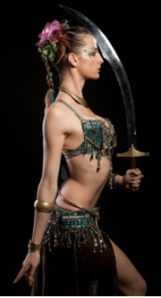
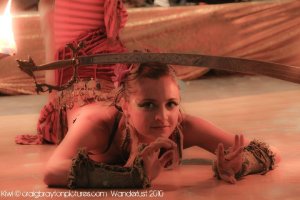
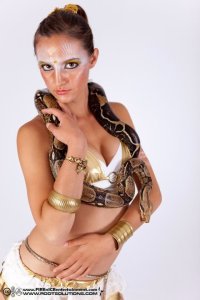
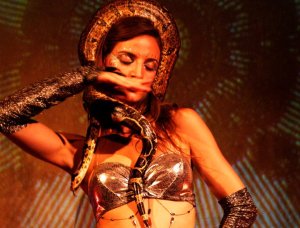
I love the way you described your experience fo this dancer. 🙂
Thank you!
(excuse the typo! I meant “of” of course!)